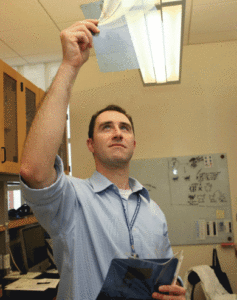Take Back Your Sex Life! Here’s How to Make it Happen. It’s the side effect that men fear most: Erectile dysfunction (ED) after surgery or radiation treatment for localized prostate cancer. As urologist Patrick Walsh, M.D., the great Johns Hopkins surgeon and my coauthor on several books about prostate cancer, always says: The first thing is to cure the cancer. Second is to preserve urinary continence. ED is third, because there are many ways to restore sexual function.
You deserve to be not only cancer-free, but to have all your parts in working order. So, if you’ve had a radical prostatectomy or radiation therapy for prostate cancer and you’re having some ED, take heart! This doesn’t mean that your sex life has to be over!
But a big part of this is up to you. If you’re having trouble and you don’t say anything, hoping for the best probably isn’t going to cut it. Ask your urologist for extra help. If you don’t get it, find another urologist.
I recently interviewed Trinity Bivalacqua, M.D., Ph.D., the R. Christian B. Evensen Professor of Urology and Oncology at Johns Hopkins, for the Prostate Cancer Foundation’s website (you can read more at pcf.org.) Here are some key points he wants you to know.
First: A lot of urologists don’t give their patients the most accurate picture of what to expect after prostate cancer treatment. There may be several reasons for this: Maybe they don’t want to admit that their results aren’t that good, or they don’t want to discourage patients from getting their prostate cancer treated by worrying them about their future sex life. We’ll get to some of that in a minute.
Second: Way too many men suffer in silence. These men – leaders at the office or in the community, respected, take-charge, tough guys – don’t ask for help. They push sex over to a quiet corner of their lives, and they’re miserable, because they assume that ED is a done deal. It’s their fate. Some things are just not meant to be, they sigh.
They give up. They tell themselves that this is how it’s always going to be – partial erection, or no erection, forever.
Come on, men: This is rehab. If you had trouble walking after a car accident or a stroke, you would accept that it’s a step-by-step process to get you back on your feet. Maybe you’d start with a wheelchair, but graduate to a walker, and then a cane. You would understand this. It would make sense to you.
It’s the same thing with your penis. There are steps. You can escalate.
Don’t give up. This is practical stuff here. If your doctor is not telling you this, print the article and take it in for your next appointment. Ask for help. If you want this to happen, help make it happen. Don’t give up.
And partners: Give the guy a break. Have some empathy. Yes, it’s frustrating for you, and it will take a lot of patience and encouragement on your part, but keep your eye on the prize: long-term success. This man just beat cancer. With your help, he can get all of his life back. It’s not going to be this way forever. Recovery of erections after surgery can take a long time – even years – to return fully. In the meantime, there are many options here. Hang in there, people. You’re not alone.
Rehabilitating Your Penis
Will your sex life be the same after surgery? The absolute honest answer is, probably not, or at least, not for a while. But the other absolute truth is just as important: You can have a good sex life after surgery.
It’s essential to know these two facts, because a lot of men don’t hear the whole truth from their doctor – or maybe they do hear it, but then focus on statistics for younger men who have never had erectile dysfunction (ED) and think the results will be the same for everybody. They won’t.
If you are in your sixties or older, have already experienced ED, and maybe you also have some other health issues, like diabetes or heart disease, then most likely you will have some ED after surgery. It happens after radiation, as well; the onset is more gradual, but the basic problem is the same – damage to the nerves and blood supply that control erection (see below).
“Erections are going to be altered from what you had before surgery,” says Bivalacqua. “Unfortunately, many doctors never provide this information; in fact, some men believe that if their erections before surgery are not as rigid as they would like, that a radical prostatectomy may actually improve them. This is definitely not the case. You may go on the Internet and find some doctor who says that 98 percent of his patients are continent and have excellent erections after surgery – but nowhere does that doctor tell you that he or she is just reporting on his youngest and best post-op cases, not on every single patient. I can’t tell you how many men come to see me and expect the same results. When they’re older and already have some trouble with ED, that’s just not going to happen.”
Bivalacqua cites a recent study in the Journal of the American Medical Association led by Harvard urologist Martin Sanda, M.D., based on data from 1,027 men with clinical stage T1 and T2 prostate cancer who had either radical prostatectomy or external-beam radiation therapy. “For a 50-year-old man with good sexual function before surgery, the probability of having good sexual function 24 months after surgery ranged from 21 to 70 percent, depending on their pre-surgery PSA and whether the nerve bundles (see below) were spared.” And for a man of any age with good sexual function before external-beam radiation therapy, “the probability of having good sexual function 24 months later ranged from 53 to 92 percent, depending on their PSA level and whether they received a short course of hormones along with their radiation therapy.”
Hold that thought. We need to take a very brief detour and have a mini-crash course in prostate anatomy. On either side of the prostate – think of Mickey Mouse’s ears, except extremely tiny and hard to see – are two bundles of nerves. They are called neurovascular bundles (that just means there are a bunch of nerves and blood vessels all clustered together). These nerve bundles were discovered by Pat Walsh, who invented the “nerve-sparing” radical prostatectomy.
Although these nerves are not in the penis itself, they are responsible for erection. They’re like junction boxes that control the wiring in a different room. Inside the penis are blood vessels; they’re like the plumbing. Basically, the erection happens when blood flows inside the penis – think of a water balloon filling up. If you have heart disease, and plaque in the arteries that can hamper blood flow, the penis (which depends on blood flow for erection) can be affected, too. This has nothing to do with the prostate, or prostate cancer, or surgery or radiation. This is just a problem you may already have.
In a nerve-sparing radical prostatectomy, if cancer is well confined within the prostate, your surgeon may be able to save one or both of those nerve bundles. You can have an erection with just one bundle. If you have both bundles removed, because your cancer is too close to that edge of the prostate, you can still have a sex life; you just will need some help with erections, and there are several options.
But first, back to your own situation: “If you have strong erections already and the nerves that control erections are spared during surgery, your chances of achieving a full recovery are excellent,” says Bivalacqua. But if, before prostate cancer treatment, you already had some mild ED, “this means that even if the nerves are spared, you will need some medication to help with erections after surgery.”
By medications, he means pills like Viagra, Cialis, Stendra, or Levitra.
Before we get into the specifics of sexual function after prostate cancer treatment, here’s one more very brief detour:
What kind of cancer do you have? If your doctor says you are a candidate for active surveillance, and you don’t have a family history of cancer and you are not of African descent, you may want to consider it, because it won’t affect your sex life or your urinary continence. However, it is not fun to get repeat biopsies, and if you are the kind of man who will constantly worry about having cancer – even if it seems unlikely to progress – this may not be for you.
If you are likely to choose surgery after a few years of active surveillance because you don’t want to live with the cancer and you want peace of mind, then please understand that your chances of recovery of potency are better sooner rather than later. Younger men who are potent before surgery do better, for the reasons discussed above.
Next, and this is huge: If you have cancer that is likely to progress beyond the prostate, you should get treatment now. Active surveillance is for a highly selected group of men with cancer that’s considered “safe.” It is completely different from not having surgery because you don’t want to have ED and hoping the cancer won’t spread. That’s actually more like denial than a good treatment strategy, and here’s why:
If you wait to have treatment, you might have more trouble than if you get treatment now. Not just because you’re more likely to recover your potency if you’re younger, but because if you don’t get treated for prostate cancer when you need it, and if that cancer progresses, you will lose much more than the ability to have an erection. If you have advanced cancer, the mainstay of treatment for metastatic disease is hormonal therapy, the shutdown of testosterone. One of the most difficult side effects of hormonal therapy is that it causes loss of sexual desire. (Note: Testosterone comes back if you stop taking the hormonal therapy, so a short course of hormonal therapy with radiation is different from taking it for the rest of your life.)
Help for ED after Prostate Surgery: The Basics
What’s the secret to having a good sex life after prostate cancer? It’s very simple, says Bivalacqua: “You use prescription erection pills. If they don’t work, you move to injectable medications. If they don’t work, you get a penile prosthesis. Also, having a loving and understanding partner always helps.” There’s also the vacuum erection device (VED). It is not a first-line treatment for ED because there’s a high drop-out rate, Bivalacqua says. However, the VED can play a very important role in another aspect of surgical recovery: penile rehabilitation (see below).
First, the pills: “When one of my patients leaves the hospital after a radical prostatectomy, he takes home a prescription for Viagra,” says Bivalacqua. Does he take it every day, like a vitamin? No. Although some doctors prescribe the pills this way, it’s not what physicians call an “evidence-based” practice; that is, the medical literature doesn’t back it up conclusively. Instead, Bivalacqua tells his patients to take it as needed. “It is very difficult for me to tell a man that he should spend $600 a month to take a daily erection drug, because the evidence of a quicker return of erections is just not there.” However, he adds, “taking a pill daily may provide a benefit, and a lot of prostate cancer patients want to take a proactive approach. If that’s the case, then I encourage them to go ahead.” Pat Walsh gives his patients samples of different types of ED medications, because each one works a little differently, so his patients can find the one that’s best for them.
Don’t just take a pill once and give up if it doesn’t work.
Taking an ED pill can boost confidence as well as help with erections, but even so, the first try might be frustrating. “I tell men that it often takes three or four attempts with Viagra to have a true response that will allow penetrative sex.” This doesn’t usually occur within the first couple of months after surgery. “Usually men see the most meaningful recovery around 9 to 12 months after surgery,” Bivalacqua notes. Just to recap here: Don’t be discouraged if the first time after surgery is not that great. And don’t give up.
Hear these words: “The penis works. The blood supply to the penis is still good.” So basically, it’s like a car that is having trouble starting. What you may need is a jump-start to get it going. That doesn’t mean you will always need this. Your body is going to continue to recover. It just means that at least right now, you might need a little help.
Now, here’s a question Bivalacqua asks all of his patients a couple months after surgery, when they are healing and are no longer having any problems with urinary leakage. (Note: not every man has urine leakage after surgery, but some men do and it is usually temporary.) “How important is it to you to have penetrative sex?” If that is very important to the man and his partner, “then I ask how often he has tried Viagra over the last four weeks.” If the man has tried it multiple times with no success, “I recommend that he start injection therapy immediately.” Remember, the penis works. “By injecting a medication that will increase the blood flow to that area, the man has a very good chance to restore erections and get that important part of his and his partner’s life back.”
Injection therapy? You mean, sticking a needle in the penis? Well, yes. But it’s a tiny needle, and your doctor won’t just hand it to you and say, “Good luck, buddy.” You will be taught how to use it. “Injection therapy allows a man to have sexual intercourse again,” says Bivalacqua. Very important: “We know that the more blood flow there is throughout the penis following a nerve-sparing radical prostatectomy, either with a pill like Viagra or with an injection of a pharmacological agent, the better the chances of regaining erections.”
Bivalacqua explains: “If you don’t have enough blood flow within the penis after surgery, it becomes ischemic; it does not get the nutrients it needs to stay healthy.”
Let’s take a moment to think about rehabilitation – say, after a bad injury. Maybe a man needs to learn to walk again, or use his hands, or how to talk again. If that guy just sits around and hopes it will happen and gets frustrated when it doesn’t, you may agree that he’s not taking the approach most likely to guarantee success. To put it bluntly, your penis needs rehab, too: “By increasing the flow of oxygenated blood to the penis, whether it is from a pill or an injection, we are able to preserve the erectile bodies (these are chambers where blood flows to provide a rigid erection), so they will respond once those nerves start to work again.”
How injection therapy works: As its name suggests, Tri-mix is actually three drugs (papaverine, phentolamine, and prostaglandin E-1). “The specific formulation of these drugs is based on the type of erection achieved with test dosages in the doctor’s office,” says Bivalacqua. “We teach the patient how to self-inject,” and understandably, this may take some getting used to. “The medication is shot into the base of the penis with a small hypodermic syringe,” and it works pretty quickly – within five to 20 minutes. What happens is that the Tri-mix causes the smooth muscle tissue in the penis to relax; it also dilates the main arteries and allows blood to fill the penis. “The erection can last between 30 and 90 minutes, and it becomes more rigid with sexual stimulation.” However, it may not always disappear right away after orgasm. (Note: After prostatectomy, there is no ejaculation, because the organs that contribute fluid for semen are gone.)
How well does it work? Pretty well; the success rate is between 70 and 80 percent. However, the main cause of failure is poor blood flow to the penis, Bivalacqua says. “Sometimes, although the shot produces an initial erection, it doesn’t last because the veins in the penis are damaged,” because of heart disease, diabetes, or other health problems, in addition to the surgery.
Each shot costs about $7, and even though it works, about half of men abandon it within a year. Bivalacqua speculates that one reason is that these men didn’t get good or detailed enough instruction for them to feel confident injecting themselves. Also, it may take two or three visits for an experienced urologist to determine the optimum combination and dosage of the medication.
The Vacuum Erection Device (VED) and penis-stretching: One fact about the penis: It needs activity. The nerves in those neurovascular bundles are also responsible for nighttime erections (in your sleep), and those “are responsible for penile health and strength.” Think of tiny push-ups happening in your sleep. After surgery – temporarily if one or both nerve bundles (the nerves to the penis) are spared – these erections don’t happen. If these bundles are damaged or removed during surgery, scar tissue can develop. When any part of the body is injured, a scar forms. This is because as it heals, tissue gets fibrosis (it hardens; this is the more rigid tissue that makes up a scar). There is extra collagen in there, and this contracts over time. This contraction can shrink the penis by as much as half an inch. Now, before you say, “That’s it! I’d rather have the cancer!” or make any hasty decisions, please read this next sentence: “The good news is that there is a way to prevent the loss of length in the penis: using a vacuum erection device,” Bivalacqua says.
Please note this important point: We’re focusing on stretching, not shrinking.
Briefly, the VED is what you might suspect; an actual vacuum. The device costs between $200 and $500, and is available from the pharmacy with a prescription. You place a clear plastic cylinder over the penis, and use either a manual or electrical pump to create negative air pressure (a vacuum). It takes about two minutes to achieve an erection; then you slip a flexible tension ring from the bottom of the cylinder around the base of the penis. This keeps the blood from flowing back out. “No matter what is specifically causing the erection, the vacuum causes the vessels in the penis to fill with blood, just as they would during a normal erection.” There’s a downside, though: “The big complaint of all men using the VED is that the penis becomes cold and semi-rigid, and this makes intercourse difficult.”
Granted, it may not be the best way for you to have sex. However, you may want to think of it more in the category of an exercise bike: It can help you get back in shape. A recent study from the Cleveland Clinic evaluated the early use of a VED after radical prostatectomy. There were 109 men in the study. “One group of 74 men used the VED at least twice a week, starting one month after surgery, for a total of nine months,” says Bivalacqua. “The second group of 35 men did not receive any erection treatment.” The study’s investigators found that “only about 23 percent of men who used the VED properly complained of decreased length and girth of the penis, compared with 85 percent in the group who did not use it as directed, twice weekly. And 63 percent of the men in the control group – who didn’t use a VED at all – reported a decrease in the length and girth of the penis. To sum up: “What the VED does is stretch the penis. It is this stretching that will prevent the penis from contracting, or shrinking, after surgery.”
If You Still Need Help
MUSE: Meh. There is another type of therapy, called MUSE. Bivalacqua doesn’t recommend it, but your doctor might talk to you about it, so here’s what it is: MUSE stands for “Medicated Urethral System for Erections.” Basically, you take a small plastic plunger, and use it to press a tiny pellet (about the size of a grain of rice) into the tip of the penis. When it dissolves, it triggers an erection. It can also burn. “Many men complain of a burning pain in the penis after inserting the pellet,” says Bivalacqua. Also, “the erection that you get is soft; it is not very rigid.” And, just as with the Tri-mix used in injection therapy , your urologist will need to determine the right dosage for you. “Some men may need double or triple the standard dose, but other men are so sensitive to the medication that they have actually fainted with the highest test dose.” Compared to an injection, “MUSE is nowhere near as effective.”
Penile Prosthesis
Instead, if pills or injections are not a good long-term solution, Bivalacqua recommends a penile prosthesis. “The device is just phenomenal,” he says. “Pills like Viagra are popular, because they’re easy to take, and when they work, they’re great. But the next most popular option is the penile prosthesis, and it works as advertised 100 percent of the time.”
It also looks 100 percent natural. It’s not some cyborg penis. For all practical purposes, it is your actual penis – just more reliable.
A penile prosthesis is an implant. It requires surgery to put it in. The procedure takes about an hour, and although it can be done on an outpatient basis, many urologists have their patients stay overnight.
How it works: Hydraulics. “The device is made up of two extremely compact, hollow cylinders,” explains Bivalacqua. These come in a variety of widths and lengths. “A small container that holds fluid is inserted in the lower part of the abdomen, and a pump is implanted in the scrotum. “ To get an erection, you squeeze the pump several times. This sends fluid from the reservoir to the inflatable cylinders, which then expand, making the penis get longer and wider – just as in a regular erection. Afterward, you squeeze a valve at the top of the pump, the fluid returns to the container in the abdomen, and the erection goes away. “The device is extremely durable and reliable,” says Bivalacqua.
In addition to the book, I have written about this story and much more about prostate cancer on the Prostate Cancer Foundation’s website, pcf.org. The stories I’ve written are under the categories, “Understanding Prostate Cancer,” and “For Patients.” As Patrick Walsh and I have said for years in our books, Knowledge is power: Saving your life may start with you going to the doctor, and knowing the right questions to ask. I hope all men will put prostate cancer on their radar. Get a baseline PSA blood test in your early 40s, and if you are of African descent, or if cancer and/or prostate cancer runs in your family, you need to be screened regularly for the disease. Many doctors don’t do this, so it’s up to you to ask for it.
©Janet Farrar Worthington


 A new blood test called the Cascade Genetic Test looks for mutations in several known “bad apple” genes.
A new blood test called the Cascade Genetic Test looks for mutations in several known “bad apple” genes. An important study, led by Fred Hutchinson Cancer Research Center medical oncologist Peter Nelson, M.D., funded in part by the Prostate Cancer Foundation, and published in the New England Journal of Medicine, is changing how we think about prostate cancer. What Nelson has found can be summed up like this:
An important study, led by Fred Hutchinson Cancer Research Center medical oncologist Peter Nelson, M.D., funded in part by the Prostate Cancer Foundation, and published in the New England Journal of Medicine, is changing how we think about prostate cancer. What Nelson has found can be summed up like this:  So don’t despair.
So don’t despair. “There’s no one way to select candidates for active surveillance,” says urologist and molecular biologist Chris Barbieri, M.D., Ph.D., of Weill Cornell Medical College/New York Presbyterian Hospital. In addition to doing molecular research on prostate cancer, he treats men with all kinds of prostate cancer and works with several hundred patients currently on active surveillance.
“There’s no one way to select candidates for active surveillance,” says urologist and molecular biologist Chris Barbieri, M.D., Ph.D., of Weill Cornell Medical College/New York Presbyterian Hospital. In addition to doing molecular research on prostate cancer, he treats men with all kinds of prostate cancer and works with several hundred patients currently on active surveillance. Can men live with slow-growing, low-volume prostate cancer?
Can men live with slow-growing, low-volume prostate cancer? You will also have to live your life knowing you have cancer.
You will also have to live your life knowing you have cancer.